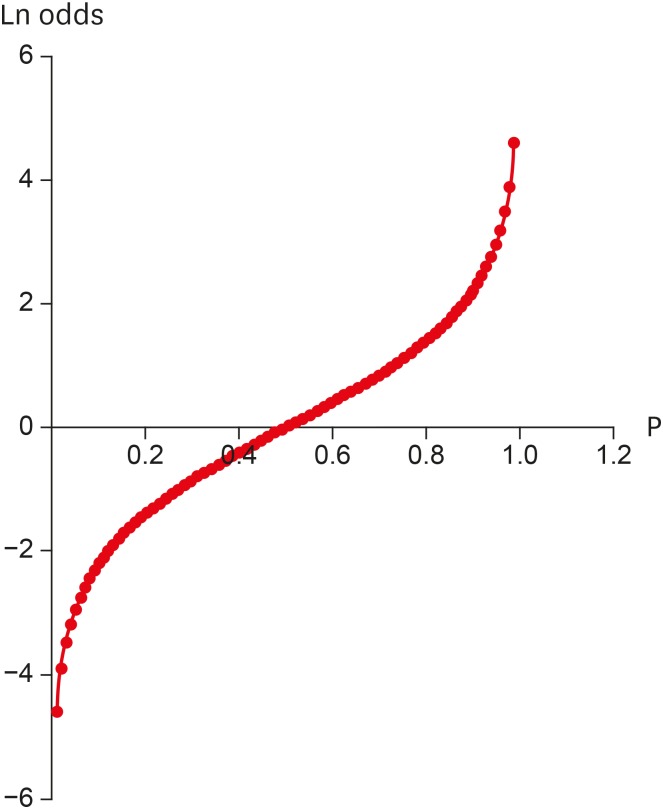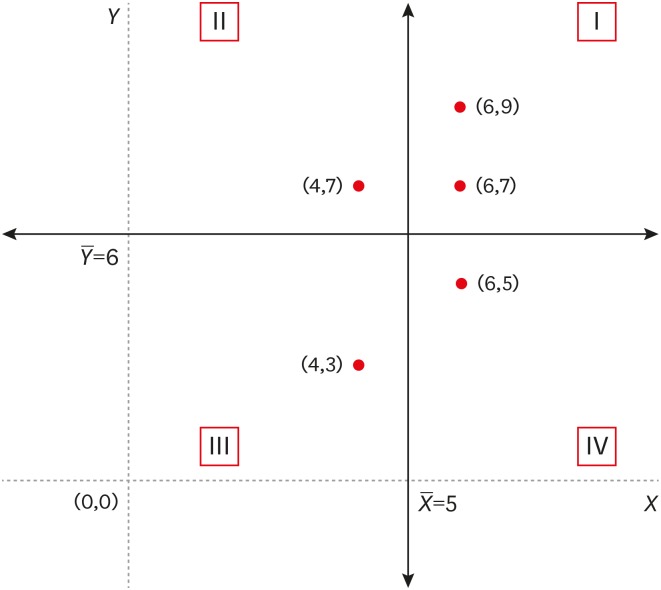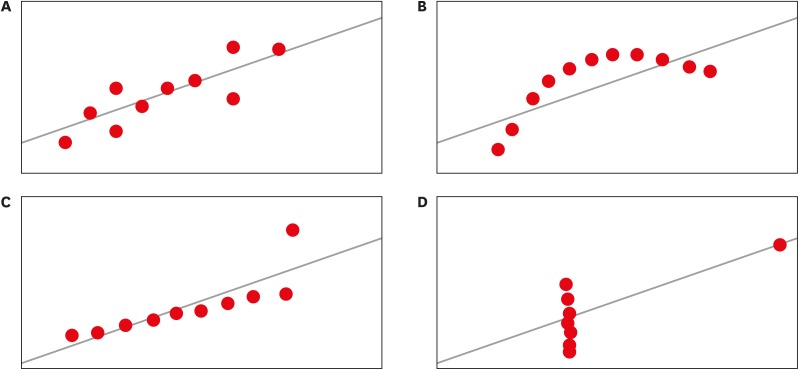Articles
- Page Path
- HOME > Restor Dent Endod > Volume 43(1); 2018 > Article
- Open Lecture on Statistics Statistical notes for clinical researchers: covariance and correlation
-
Hae-Young Kim

-
Restor Dent Endod 2018;43(1):e4.
DOI: https://doi.org/10.5395/rde.2018.43.e4
Published online: January 5, 2018
Department of Health Policy and Management, College of Health Science, and Department of Public Health Science, Graduate School, Korea University, Seoul, Korea.
- Correspondence to Hae-Young Kim, DDS, PhD. Department of Health Policy and Management, College of Health Science, and Department of Public Health Science, Graduate School, Korea University, 145 Anam-ro, Seongbuk-gu, Seoul 02841, Korea. Tel: +82-2-3290-5667, Fax: +82-2-940-2879, kimhaey@korea.ac.kr
Copyright © 2018. The Korean Academy of Conservative Dentistry
This is an Open Access article distributed under the terms of the Creative Commons Attribution Non-Commercial License (https://creativecommons.org/licenses/by-nc/4.0/) which permits unrestricted non-commercial use, distribution, and reproduction in any medium, provided the original work is properly cited.
- 2,553 Views
- 46 Download
- 16 Crossref
COVARIANCE
 and
and  . Covariance is expressed as following formula:
. Covariance is expressed as following formula: = 5 and
= 5 and  = 6 (solid line). In the quadrant I, x value moves positively from its mean and so does y value. Therefore, the points in the quadrant I represent positive relationship between two variables because Y values get larger as X values get larger relatively to their mean. Similarly, the points in the quadrant III also represent positive relationship because Y values get smaller than its mean as X values get smaller. The sign of the multiplicative value of each deviation,
= 6 (solid line). In the quadrant I, x value moves positively from its mean and so does y value. Therefore, the points in the quadrant I represent positive relationship between two variables because Y values get larger as X values get larger relatively to their mean. Similarly, the points in the quadrant III also represent positive relationship because Y values get smaller than its mean as X values get smaller. The sign of the multiplicative value of each deviation,  is positive in the quadrants I and III because the pair of deviations have the same sign that both are positive or negative. Contrary, the points in quadrants II and IV show negative relationship as one variable gets larger than its mean as the other gets smaller (Figure 1). In quadrants II and IV, the sign of the multiplicative value of each deviation is negative because the pair of deviations have different signs each other.
is positive in the quadrants I and III because the pair of deviations have the same sign that both are positive or negative. Contrary, the points in quadrants II and IV show negative relationship as one variable gets larger than its mean as the other gets smaller (Figure 1). In quadrants II and IV, the sign of the multiplicative value of each deviation is negative because the pair of deviations have different signs each other.The calculation procedure of covariance and Pearson correlation coefficient
PEARSON CORRELATION COEFFICIENT


SPEARMAN'S RANK CORRELATION COEFFICIENT
 . As seen Figure 4, Spearman correlation coefficient is 1 when y values always increase as x values increase, while Pearson correlation coefficient counts only linearity with coefficient of 0.97. Spearman rank correlation coefficient can be applied on continuous variables with influential outliers which are located far away from most observations. In such cases, it is not appropriate to apply Pearson. Also, it can be applied to assess relationships between ordered categorical values. The range of Spearman correlation coefficient is from −1 to +1, which represent perfect negative and positive relationships, respectively.
. As seen Figure 4, Spearman correlation coefficient is 1 when y values always increase as x values increase, while Pearson correlation coefficient counts only linearity with coefficient of 0.97. Spearman rank correlation coefficient can be applied on continuous variables with influential outliers which are located far away from most observations. In such cases, it is not appropriate to apply Pearson. Also, it can be applied to assess relationships between ordered categorical values. The range of Spearman correlation coefficient is from −1 to +1, which represent perfect negative and positive relationships, respectively.
The calculation procedure of the Spearman's rank correlation
Appendix
Tables & Figures
REFERENCES
Citations

- Occupational Lead Exposure Among Civilian Indoor Shooting Range Workers in Korea: A Report of Blood Lead Levels and Airborne Lead
Sungjin Park, Jaeyoung Park, Bumjoon Lee, Yi-Ryoung Lee, Jiho Kim, Younmo Cho, Hyeongyeong Choi, Kyeongyeon Kim
Journal of Korean Medical Science.2025;[Epub] CrossRef - Relationship of incidence of radix entomolaris and C‐shaped canal in mandibular molars using CBCT: A multi‐centre study
Sobrina Mohamed Khazin, Siti Hajar Omar, Marlena Kamaruzaman, Huwaina Abd Ghani, Mandava Deepthi, Diyana Kamarudin, Safura Anita Baharin, Vinayak Pishipati Kalyan Chakravarthy
Australian Endodontic Journal.2025; 51(1): 26. CrossRef - Advancing building façade design: digital fabrication of an optimized non-conventional roster brick prototype
Dalhar Susanto, Raisa Putri Alifa, Stefanie Aylien, Miktha Farid Alkadri
Journal of Asian Architecture and Building Engineering.2025; : 1. CrossRef - A Study on Gender Differences in the Maximum Attractiveness Values for Cephalometric Measures
Xiaofan Feng, Xin Chen, Hongyu Ren
Journal of Craniofacial Surgery.2025; 36(7): e1080. CrossRef - Feasibility study of microwave‐induced thermoacoustic/ultrasound dual‐modality imaging for the assessment of nonalcoholic fatty liver disease
Jieni Song, Wenwu Ling, Wanting Peng, Ling Song, Zeqi Yang, Lian Feng, Lin Huang, Yan Luo
Medical Physics.2025;[Epub] CrossRef - Improving the forecast accuracy of wind power by leveraging multiple hierarchical structure
Lucas English, Mahdi Abolghasemi
Sustainable Energy, Grids and Networks.2024; 40: 101517. CrossRef - Simplified Methods for Modelling Dependent Parameters in Health Economic Evaluations: A Tutorial
Xuanqian Xie, Alexis K. Schaink, Sichen Liu, Myra Wang, Juan David Rios, Andrei Volodin
Applied Health Economics and Health Policy.2024; 22(3): 331. CrossRef - Numerical modeling of ocean currents and suspended sediment distribution in Benoa Bay, Bali
Siti Sulistiana, I Wayan Nurjaya, Mochamad Tri Hartanto, H.M. Manik, N.P. Zamani, J. Lumban Gaol, A.S. Atmadipoera, O. Meng Chuan, T. Osawa
BIO Web of Conferences.2024; 106: 03005. CrossRef - The effectiveness of the TRACE online nutrition intervention in improving dietary intake, sleep quality and physical activity levels for Australian adults with food addiction: a randomised controlled trial
Mark Leary, Janelle A. Skinner, Kirrilly M. Pursey, Antonio Verdejo‐Garcia, Rebecca Collins, Clare Collins, Phillipa Hay, Tracy L. Burrows
Journal of Human Nutrition and Dietetics.2024; 37(4): 978. CrossRef - Influence of the radius of Monson’s sphere and excursive occlusal contacts on masticatory function of dentate subjects
Dominique Ellen Carneiro, Luiz Ricardo Marafigo Zander, Carolina Ruppel, Giancarlo De La Torre Canales, Rubén Auccaise-Estrada, Alfonso Sánchez-Ayala
Archives of Oral Biology.2024; 159: 105879. CrossRef - Analytical Performance Specifications for Input Variables: Investigation of the Model of End-Stage Liver Disease
Eline S Andersen, Richard Röttger, Claus L Brasen, Ivan Brandslund
Clinical Chemistry.2024; 70(4): 653. CrossRef - A prototype variable corresponding to the proportion of ischemia for the comparison between robotic and open partial nephrectomy: a meta-analysis accompanied by sensitivity analysis
Sotirios Artsitas, Dimitrios Artsitas, Irene Koronaki, Konstantinos G. Toutouzas, George C. Zografos
Beni-Suef University Journal of Basic and Applied Sciences.2023;[Epub] CrossRef - Cephalometric determinants of facial attractiveness: A quadratic correlation study
Joana Godinho, Diana Fernandes, Patrícia Pires, Luis Jardim
American Journal of Orthodontics and Dentofacial Orthopedics.2023; 163(3): 398. CrossRef - Sympathovagal Balance Is a Strong Predictor of Post High-Volume Endurance Exercise Cardiac Arrhythmia
Daniel W. T. Wundersitz, Bradley J. Wright, Brett A. Gordon, Stephanie Pompei, Carl J. Lavie, Voltaire Nadurata, Kimberly Nolan, Michael I. C. Kingsley
Frontiers in Physiology.2022;[Epub] CrossRef - Performance investigation of the natural draft wet cooling tower at different wet-bulb temperatures
Gaurav Raj, Prakash Chandra, Piyush Kumar Pathak
International Journal of Ambient Energy.2022; 43(1): 5864. CrossRef - Statistical notes for clinical researchers: simple linear regression 1 – basic concepts
Hae-Young Kim
Restorative Dentistry & Endodontics.2018;[Epub] CrossRef




Figure 1
Figure 2
Figure 3
Figure 4
The calculation procedure of covariance and Pearson correlation coefficient
| No | X | Y | X−X̄ | Y−Ȳ | (X−X̄)2 | (Y−Ȳ)2 | (X−X̄)(Y−Ȳ) |
|---|---|---|---|---|---|---|---|
| 1 | 73 | 90 | 0.55 | 7.65 | 0.30 | 58.52 | 4.21 |
| 2 | 52 | 74 | −20.45 | −8.35 | 418.20 | 69.72 | 170.76 |
| 3 | 68 | 91 | −4.45 | 8.65 | 19.80 | 74.82 | −38.49 |
| 4 | 47 | 62 | −25.45 | −20.35 | 647.70 | 414.12 | 517.91 |
| 5 | 60 | 63 | −12.45 | −19.35 | 155.00 | 374.42 | 240.91 |
| 6 | 71 | 78 | −1.45 | −4.35 | 2.10 | 18.92 | 6.31 |
| 7 | 67 | 60 | −5.45 | −22.35 | 29.70 | 499.52 | 121.81 |
| 8 | 80 | 89 | 7.55 | 6.65 | 57.00 | 44.22 | 50.21 |
| 9 | 86 | 82 | 13.55 | −0.35 | 183.60 | 0.12 | −4.74 |
| 10 | 91 | 105 | 18.55 | 22.65 | 344.10 | 513.02 | 420.16 |
| 11 | 67 | 76 | −5.45 | −6.35 | 29.70 | 40.32 | 34.61 |
| 12 | 73 | 82 | 0.55 | −0.35 | 0.30 | 0.12 | −0.19 |
| 13 | 71 | 93 | −1.45 | 10.65 | 2.10 | 113.42 | −15.44 |
| 14 | 57 | 73 | −15.45 | −9.35 | 238.70 | 87.42 | 144.46 |
| 15 | 86 | 82 | 13.55 | −0.35 | 183.60 | 0.12 | −4.74 |
| 16 | 76 | 88 | 3.55 | 5.65 | 12.60 | 31.92 | 20.06 |
| 17 | 91 | 97 | 18.55 | 14.65 | 344.10 | 214.62 | 271.76 |
| 18 | 69 | 80 | −3.45 | −2.35 | 11.90 | 5.52 | 8.11 |
| 19 | 87 | 87 | 14.55 | 4.65 | 211.70 | 21.62 | 67.66 |
| 20 | 77 | 95 | 4.55 | 12.65 | 20.70 | 160.02 | 57.56 |
| X̄ = 72.45 | Ȳ = 82.35 | ∑ = 2,912.95 | ∑ = 2,742.55 | ∑ = 2,072.85 |
The calculation procedure of the Spearman's rank correlation
| No | X | Y | Rank(X) | Rank(Y) | d* | d2 |
|---|---|---|---|---|---|---|
| 1 | 73 | 90 | 11.5 | 15 | 3.5 | 12.25 |
| 2 | 52 | 74 | 2 | 5 | 3 | 9 |
| 3 | 68 | 91 | 7 | 16 | 9 | 81 |
| 4 | 47 | 62 | 1 | 2 | 1 | 1 |
| 5 | 60 | 63 | 4 | 3 | −1 | 1 |
| 6 | 71 | 78 | 9.5 | 7 | −2.5 | 6.25 |
| 7 | 67 | 60 | 5.5 | 1 | −4.5 | 20.25 |
| 8 | 80 | 89 | 15 | 14 | −1 | 1 |
| 9 | 86 | 82 | 16.5 | 10 | −6.5 | 42.25 |
| 10 | 91 | 105 | 19.5 | 20 | 0.5 | 0.25 |
| 11 | 67 | 76 | 5.5 | 6 | 0.5 | 0.25 |
| 12 | 73 | 82 | 11.5 | 10 | −1.5 | 2.25 |
| 13 | 71 | 93 | 9.5 | 17 | 7.5 | 56.25 |
| 14 | 57 | 73 | 3 | 4 | 1 | 1 |
| 15 | 86 | 82 | 16.5 | 10 | −6.5 | 42.25 |
| 16 | 76 | 88 | 13 | 13 | 0 | 0 |
| 17 | 91 | 97 | 19.5 | 19 | −0.5 | 0.25 |
| 18 | 69 | 80 | 8 | 8 | 0 | 0 |
| 19 | 87 | 87 | 18 | 12 | −6 | 36 |
| 20 | 77 | 95 | 14 | 18 | 4 | 16 |
| ∑ = 328.5 |
*d = Rank(Y) − Rank(X).
*

 KACD
KACD


 ePub Link
ePub Link Cite
Cite

